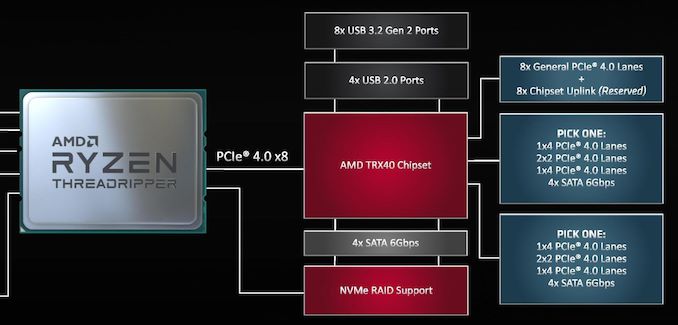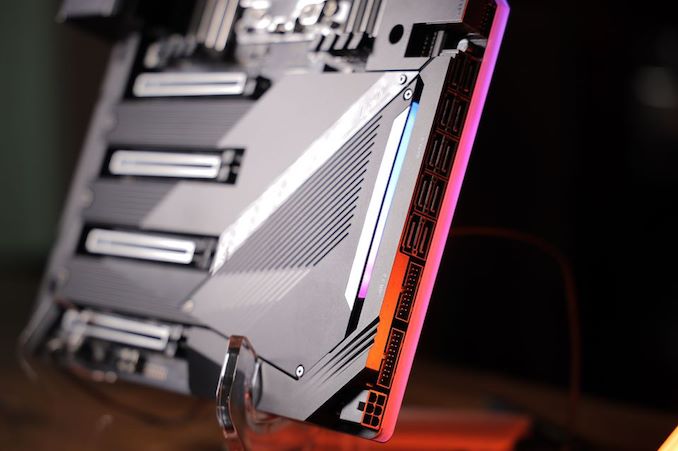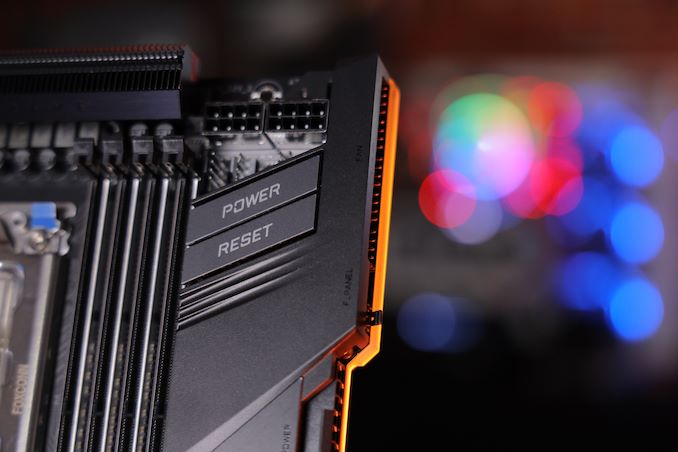AMD Q4: 16-core Ryzen 9 3950X, Threadripper Up To 32-Core 3970X, Coming November 25th
by Dr. Ian Cutress on November 7, 2019 9:00 AM ESTTRX40: More High-End Motherboards for TR3
The new sTRX4 socket will be paired with a TRX40 chipset – a design that AMD says comes from an in-house team and built on GlobalFoundries 14nm. The new chipset, updated from the previous X399 in this space and even updated from the X570 in the consumer space, is the other half in the CPU-to-chipset bandwidth story. By using a PCIe 4.0 x8 link, AMD is removing almost any practical bandwidth limitation downstream from the CPU.
The new TRX40 chipset will come with a degree of modularity.
From the chipset, we can see motherboard manufacturers afforded a full PCIe 4.0 x8 slot, up to another x8 lanes as two x4 connections or further bifurcated, or instead of those bifurcated lanes, either four or eight more SATA ports. That’s 8 SATA ports on top of the four already present on the chipset.
So I like these modular systems. It allows motherboard manufacturers to go crazy with offering potential systems. For example:
| Potential TRX40 Variants | |||||||
| AnandTech | CPU | Chipset | |||||
| TRX40 SATA Powerhouse 20 drives |
x48 for PCIe slots | x8 for downlink | 8x SATA from options | x8 for dual NVMe | 8x SATA from options | 4x SATA from chipset | |
| TRX40 NVMe Powerhouse 18+ drives |
x48 for PCIe slots | x8 for downlink | dual NVMe from options | x8 for dual NVMe | dual NVMe for options | - | |
So that would be a motherboard with x16/x16/x16 (or x16/x8/x16/x8) in terms of PCIe 4.0 slots, a single x8 slot for a pair of NVMe drives, and then TWENTY SATA ports, all directly supported on the system without any additional controllers.
If SATA isn’t your thing, then the same arguments could be made for 48 PCIe lanes and six PCIe 4.0 x4 NVMe slots, making a total of 18 high capacity PCIe 4.0 drives. The fact that AMD has put more PCIe lanes into their high end desktop platforms, plus this amount of modularity, wants me to play Dr. Frankenstein.
To be fair, those ideas are a bit extreme. Motherboard manufacturers will likely have to partition off a few lanes for 10 GbE networking, perhaps Thunderbolt, or maybe something more exotic like a RAID controller, or an RGB controller.
As noted in some of our previous news posts, motherboard manufacturers have been slowly leaking names of their TRX40 products. At this point in time we have seen mentions of the following:
- ASRock TRX40 Creator
- ASRock TRX40 Taichi
- GIGABYTE TRX40 AORUS XTREME
- ASUS Prime TRX40 Pro
- ASUS ROG Zenith II Extreme
- MSI TRX40 Creator
- MSI TRX40 Pro 10G
- MSI TRX40 Pro Wi-Fi
We expect details of some of these to perhaps be announced today, or on the 25th when the CPUs come to market. GIGABYTE has even been showing previews of their motherboards on social media, with one showing an obscene number of power phases, and we’ve seen images of boards with 8 SATA ports. We’ll have our usual motherboard overview article up on that date, and we’ll be looking at reviews of these motherboards through the new year.
I will address comments about potential TRX80/WRX80 motherboards which have been put into the ether as potential other chipsets being launched. When asked, AMD said that the only chipset they are launching today is TRX40.













171 Comments
View All Comments
cfenton - Thursday, November 7, 2019 - link
Almost nothing. These things are for work. A reasonably fast quad core (anything Ivy Bridge or newer, really) is fine for almost any casual programs. Going up to eight cores makes sense for gaming since the new consoles will be eight core.TheinsanegamerN - Thursday, November 7, 2019 - link
The consoles have been 8 core since 2013 dude. PS4 and xbone are 8 core. 8 slow cores, which should have prompted swift acceleration of multi threaded game engines.Yet here we are.
milkywayer - Thursday, November 7, 2019 - link
Half of this console generation Intel was in the lead and they kept milking the core count. Until 3,4 years ago they were selling dual core cpu as i7 on mobile. It wasn't until AMD came up and basically showered everyone with 4 and 6 core cpus for half the price is when Intel dropped the BS and started offering real 6 core cpus in the lower tier consumer market and 4 core real 4 core cpus in mobile etc. I blame only Intel.cfenton - Thursday, November 7, 2019 - link
And we saw slow progress toward multi-threaded games throughout the generation. There are way more games today that can take advantage of 4+ cores than there were in 2013. It takes time to adapt game engines and not every kind of game will even benefit from more cores. All I'm suggesting is that if you play games you have some reason to go beyond four cores.evernessince - Thursday, November 7, 2019 - link
Consoles were based off jaguar, which really had 8 half cores that shared execution units. So really, 4 cores.scineram - Friday, November 8, 2019 - link
No.Spunjji - Friday, November 8, 2019 - link
You're confusing Jaguar for Bulldozer.Jaguar uses complete cores, albeit "small" ones in terms of area - in design and performance terms they're somewhere between the old K8 Athlon 64 and K10 Athlon II processors.
I think the confusion comes in because the console implementation of Jaguar has 8 cores split across 2 "modules" which is the same terminology used for 'dozer, but referring to a different thing:
Bulldozer module = 2 cores with shared FP resources
Jaguar module = 4 independent cores, like a CCX in Zen
Zizy - Friday, November 8, 2019 - link
8 cores at 1.6GHz (PS4 as the slowest) is at best the same as 4 cores at 3.2 GHz, assuming everything else equal and perfect MT. Plus those cat cores were essentially half as capable as the current stuff, normalized by clock. Therefore, consoles have about the same as 2 proper desktop cores - the lowest end CPUs you can buy.Anyway, there are many games that use more than 4 cores these days. Especially stuff coming out now when also Intel started offering more cores and AMD having competitive if not superior chips.
nevcairiel - Thursday, November 7, 2019 - link
Casual everyday users absolutely do not need such CPUs.DigitalFreak - Thursday, November 7, 2019 - link
Exactly right. Core count is the new Mhz race for the uninformed.